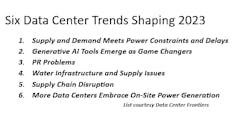Data Center Dilemma: AI, FutureTech Driving Demand that Traditional Grid Power May Not Match
So fast, in fact, few of us can keep up or even know where it's going. Increasingly abundant and always in high demand, the rush for data center capacity is moving faster than even the utility-scale electric power required to keep the facilities running.
All of these facilities surely have backup power in generator sets, but should more multi-faceted, efficient and sustainable microgrids fill the gaps?
In its new report, “Global Data Center Trends 2023,” CBRE Group, one of the largest U.S. real estate management and investment firm, details how the rise of artificial intelligence, machine learning, control systems, gaming, and autonomous technologies are pushing the rise of data beyond its already steep growth curve...and a little past what energy can do to support it.
No matter the industry, data is now as foundational as hardware, and, as a result, the power sector is being challenged to provide enough generation to sustain that exponential expansion across the world.
“Higher energy costs have also not materially slowed development, but power availability and bottlenecks are challenges,” reads the CBRE report. “Local governments are working to address permitting and planning backlogs on transmission projects, particularly as utility companies aim to connect renewable energy to the grid.”
Uncommon Commonwealth: Virginia's preeminence in Data Center Inventory
To paraphrase George McFly in “Back to the Future,” it is our density, power-wise, which is needed to meet the destiny of ever more datum.
According to CBRE, this portion of Northern Virginia–specifically Loudoun, Prince William and Fairfax counties, is the United States’ biggest market for data centers. The region's approximately 2,132- MW inventory makes it an economic colossus, but also an energy sink. Currently, about 34% of data center power supply comes from nuclear plants, which is carbon free. Nuclear provides the biggest pushback against electricity bottlenecks, which may take years to fully resolve.
A recent story by Microgrid Knowledge contributor Lisa Cohn noted that data centers consume close to 22% of grid power generation statewide. Virginia-based utility Dominion Energy is putting forward a plan to build new capacity, but this has ignited criticism from clean energy advocates who are upset about the possibility of additional new gas-fired power plants. According to groups like the Sierra Club, this is taking energy transition in the wrong direction.
Follow us on Twitter @MicrogridNews and LinkedIn
This dilemma has led to some advocating for microgrids to be built on-site. These systems could include solar, battery storage and gas or renewable natural gas gen-sets, which release cleaner emissions than diesel models.
“Data center microgrids can help balance demand from the existing aged grid, either working integrated or islanded to manage power and peaking capacity,” Dean Richards, president and CEO of Pillar Power Systems, told Microgrid Knowledge. “This will de-stress the grid infrastructure and embrace greener energy generation at the local community level.”
Other Data Center destinations and other challenges
Silicon Valley and the Dallas/Fort Worth area, according to the CBRE report, are among the next biggest data center markets in the U.S. The tech bastion of northern California is buoyed by an endless array of tech startups and established leaders, but land prices and a dearth of utility-scale and flexible power generation are extreme challenges to the future.
In Texas, the state’s power transmission and distribution processes are optimized and streamlined for quicker deployment. Yet the self-contained Electric Reliability Council of Texas grid system, which is not interconnected to other regional grids, has experienced a series of devastating weather events and forced outages in recent years.
Other regions in the U.S. and around the world are pursuing data center construction and connection, spurred by this unprecedented growth of cyber tools and technologies. Many would-be data center homes face the same dangers of a large and sometimes inflexible transmission grid system.
These problems can be fixed, but it might take years to catch up with the boundless energy and pace of data center growth.
The golden hare of data center growth is speeding ahead all day, every day. It needs an equally speedy and adaptive running partner, and microgrids could be called upon to maintain that pace.
About the Author
Rod Walton, Microgrid Knowledge Managing Editor
Managing Editor
For Microgrid Knowledge editorial inquiries, please contact Managing Editor Rod Walton at [email protected].
I’ve spent the last 15 years covering the energy industry as a newspaper and trade journalist. I was an energy writer and business editor at the Tulsa World before moving to business-to-business media at PennWell Publishing, which later became Clarion Events, where I covered the electric power industry. I joined Endeavor Business Media in November 2021 to help launch EnergyTech, one of the company’s newest media brands. I joined Microgrid Knowledge in July 2023.
I earned my Bachelors degree in journalism from the University of Oklahoma. My career stops include the Moore American, Bartlesville Examiner-Enterprise, Wagoner Tribune and Tulsa World, all in Oklahoma . I have been married to Laura for the past 33-plus years and we have four children and one adorable granddaughter. We want the energy transition to make their lives better in the future.
Microgrid Knowledge and EnergyTech are focused on the mission critical and large-scale energy users and their sustainability and resiliency goals. These include the commercial and industrial sectors, as well as the military, universities, data centers and microgrids. The C&I sectors together account for close to 30 percent of greenhouse gas emissions in the U.S.
Many large-scale energy users such as Fortune 500 companies, and mission-critical users such as military bases, universities, healthcare facilities, public safety and data centers, shifting their energy priorities to reach net-zero carbon goals within the coming decades. These include plans for renewable energy power purchase agreements, but also on-site resiliency projects such as microgrids, combined heat and power, rooftop solar, energy storage, digitalization and building efficiency upgrades.


